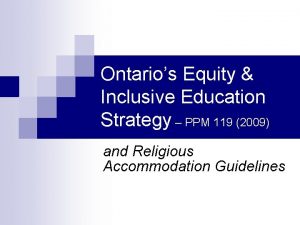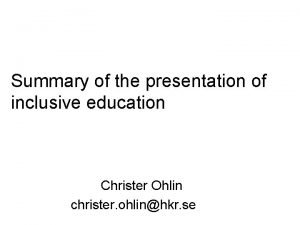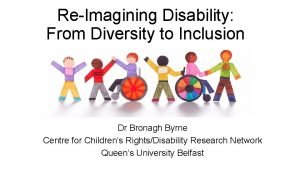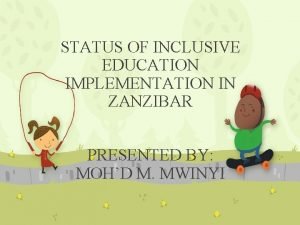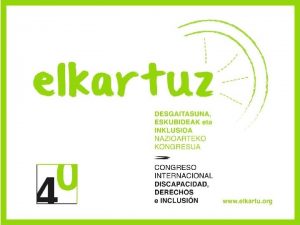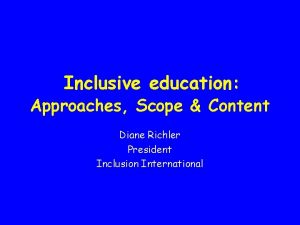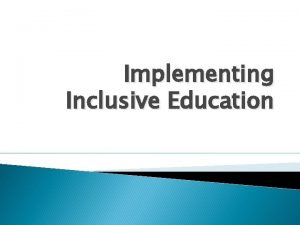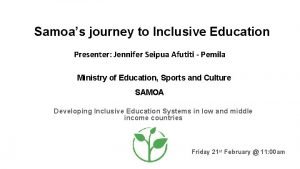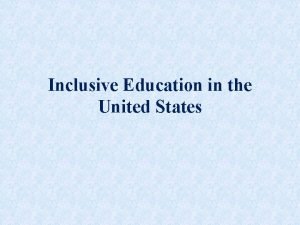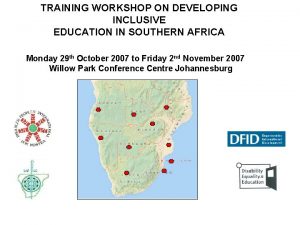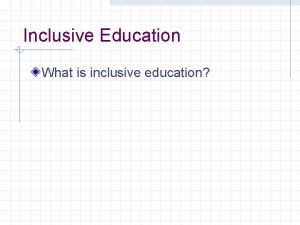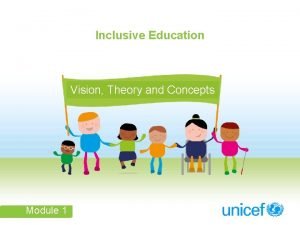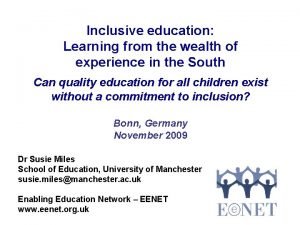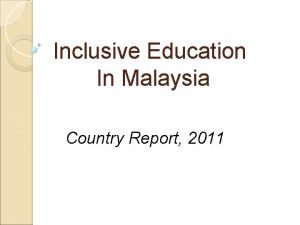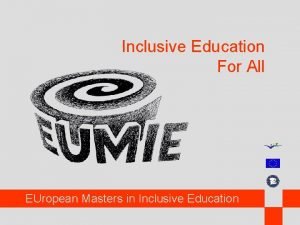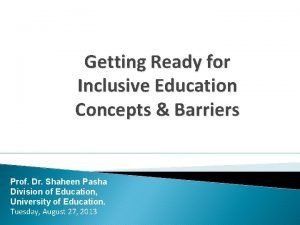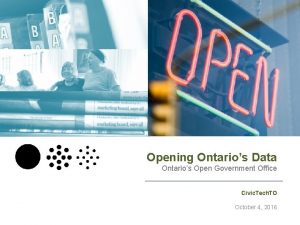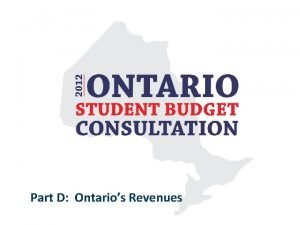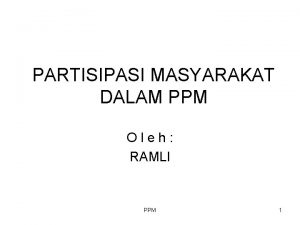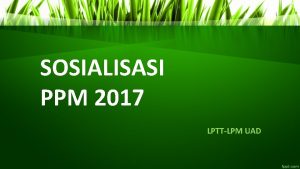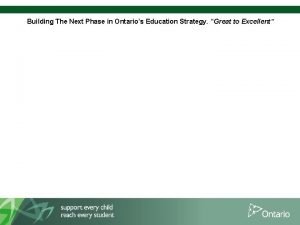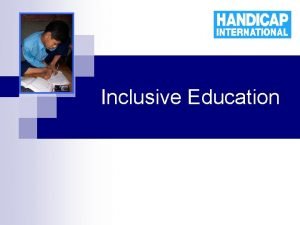Ontarios Equity Inclusive Education Strategy PPM 119 2009





















- Slides: 21

Ontario’s Equity & Inclusive Education Strategy – PPM 119 (2009) and Religious Accommodation Guidelines

Key Action Items § Boards will review or develop a policy on equity and inclusive education including a guideline on religious accommodation for implementation by September 2010. § The implementation phase will be done over a period of four years (2008 -2009 to 2011 -2012).

Introduction n There is a direct link between success at school and a school’s learning environment. Research and experience indicate that students are more able and more motivated to do well and achieve their full potential in schools where they feel safe, supported and welcomed. (Safe Schools Action Team, 2008). n Research findings about the effects of rejection and bullying on young people are clear and consistent. Rejection, exclusion and estrangement are associated with behaviour problems in the classroom, lower interest in school, lower student achievement, and higher dropout rates. (Osterman 2000). n Positive results of a genuine partnership between parents and schools include improved student achievement, reduced absenteeism, better behaviour, and increased public confidence among parents in their children’s schooling.

Inclusive Education Branch The Inclusive Education Branch (IEB) was established in October 2008, and as of August 2009, the Parent Engagement Office is part of the branch. The branch: n n n supports the development, implementation, training and monitoring of equity and inclusive education policies. identifies and promotes specific parent engagement practices that are known to be effective in supporting student achievement. provides base funding for school councils and parent involvement committees. provides Parents Reaching Out (PRO) Grants – a specific focus on reaching parents who face barriers. acts as liaison between the Ministry and the Ontario Human Rights Commission (OHRC).

Definitions n Diversity: The presence of a wide range of human qualities and attributes within a group, organization, or society. The dimensions of diversity include, but are not limited to, ancestry, culture, ethnicity, gender identity, language, physical and intellectual ability, race, religious, sexual orientation, and socio-economic status. n Equity: A condition or state of fair, inclusive, and respectful treatment of all people. Equity does not mean treating people the same without regard for individual differences.

Definitions n Inclusive Education: Education that is based on the principles of acceptance and inclusion of all students. Students see themselves reflected in their curriculum, their physical surroundings, and the broader environment, in which diversity is honoured and all individuals are respected.

Background n Policy/Program Memorandum (PPM) No. 119, Development and Implementation of School Board Policies on Antiracism and Ethnocultural Equity (1993). o To date only 43 of Ontario’s 72 school boards report that they currently have some form of equity policy in place. o Only 12 boards report that they have policies or guidelines relating to religious accommodation. o Only 3 of those could be considered comprehensive.

The Need for Action n Ongoing incidents of discrimination, homophobia, cyberbullying and hate propaganda. n “. . . Supreme Court of Canada (2005) acknowledged that racial prejudice against visible minorities is so notorious and indisputable that its existence needs to be treated as a social fact. ” n Documented increase in reported incidents of anti-Black racism, antisemitism, and Islamophobia in Canada. n 2007/08 Annual Report of the OHRC shows that complaints based on race and disability outnumber all others. n The new Policy/Program Memorandum (PPM) No. 119, “Developing and Implementing Equity and Inclusive Education Policies in Ontario Schools (2009)”, broadens the scope of the former PPM 119 (1993) and “does not reflect a weakened or reduced commitment to antiracism or equity. ”

Equity and Inclusive Education Strategy Highlights Ontario’s Equity and Inclusive Education Strategy: n establishes a framework to help Ontario’s education community identify and remove discriminatory biases and systemic barriers to student achievement related to the prohibited grounds of discrimination set out in the Ontario Human Rights Code, and other related factors (e. g. socio-economic status) n recognizes that the intersection of overlapping dimensions (e. g. race, sexual orientation and poverty) may create biases and barriers to student achievement. n supports the government’s core education priorities, i. e. high levels of student achievement, reduced gaps in student achievement and increased public confidence in publicly-funded education. n builds on successful Ministry, school board and school policies and practices.

Legislative and Policy Context The Strategy: § is to be implemented within the context of the Education Act, which affirms the constitutional rights of Catholic and French-language rights holders in Ontario. § is in line with the principles outlined in Ontario’s Aménagement linguistique Policy for French-Language Education. § reflects the values outlined in the Ontario Catholic School Graduate Expectations.

Policy Development n A boards’ equity and inclusive education policy is expected to be comprehensive, cover the prohibited grounds of discrimination set out in the Ontario Human Rights Code and may include other similar factors (e. g. socio-economic) ¨ n Grounds may be related to ancestry, culture, ethnicity, gender-identity, language, physical and intellectual ability, race, religion, sexual orientation, or other similar factors Intersecting Grounds of Discrimination ¨ For example, the prohibited grounds of race, religion, and disability can intersect in one individual.

Vision n Equity and inclusiveness are internationally recognized as critical to the delivery of a high quality education in a global, knowledge-based economy (UNESCO, 2008). n The Ontario’s Equity and Inclusive Education Strategy (2009) sets out a vision for an equitable and inclusive education system where: ¨ all students, parents and members of the school community are welcomed and respected, ¨ every student is supported and inspired to succeed in a culture of high expectations for learning.

Guiding Principles of the Equity and Inclusive Education Strategy Equity and inclusive education: n is a foundation of excellence; n meets individual needs; n identifies and eliminates barriers; n promotes a sense of belonging; n involves the broad community; n builds on and enhances previous and existing initiatives; n is demonstrated throughout the system.

Action Items – Board Key Commitments n n n Develop or revise policies on equity and inclusive education for implementation by September 2010 include a guideline on religious accommodation. Embed equity and inclusive education principles in board and school improvement plans. Review and revise existing community partnerships so that they support the principles of equity and inclusive education and reflect the diversity of the broader community. Develop procedures that will enable students and staff to report incidents of discrimination and harassment safely and that will also enable boards to respond in a timely manner. Develop active outreach and engagement strategies that will identify and remove systemic barriers that limit engagement with students, parents and the community. Review resources, classroom instruction and student assessment and evaluation practices to identify and remove discriminatory biases and systemic barriers that may exist.

Religious Accommodation Guidelines Action Items – Year 2: 2009 -2010 School Boards will: § Have religious accommodation guidelines in place, and communicate these guidelines to the school community.

Policy on Creed and the Accommodation of Religious Observances n Creed is interpreted by the Ontario Human Rights Commission to mean "religious creed" or "religion". Creed is "a professed system and confession of faith, including both beliefs and observances or worship“ that is "sincerely held" and includes non-deistic belief systems. (Freedom to practice) n Creed does not include "secular, moral, or ethical beliefs or political convictions" or "religions that promote violence or hate towards others or that violate criminal law". (Limits) n Individuals who do not belong to a religion or practice any specific faith are also protected by the Code. (Protects)

The Code n Allows freedom to practice or not to practice n Prevents discrimination and harassment n Imposes a duty to accommodate: ¨ Accommodation is required under the Code to be considered on an individual basis “unless it would cause undue hardship because of cost, or health and safety reasons”.

Development of Guideline on Religious Accommodation n Develop the guideline in partnership with diverse stakeholders, including multiple faith communities and individuals who do not belong to any religious community; n Communicate the guideline to students, parents, teachers, employees, school councils and volunteers; n Identify community resources that provide information to school staff about the faith needs of individuals.

Possible Areas of Accommodation n Observation of major religious holy days, commemorations, and celebrations n School opening and closing exercises n Prayer/rituals n Dietary requirements n Religious attire n Modesty requirements in physical education activities n Participation in daily activities and curriculum (Guidelines, 2009, p. 61)

Resources n Sample Template Religious Accommodation (Guideline, pp. 61 -62) n OHRC Resources (Guidelines, 2009, pp. 83 -85) n Multifaith Calendar, 2009 (www. unityarts. com) n Multifaith Information Manual (sales@omc. ca)

Notes n Please review this presentation as often as you like, so that you are aware of your obligations under the Safe Schools legislation, and are working to achieve an equitable and inclusive school climate for all members of our school communities.
 Ontario's equity and inclusive education strategy
Ontario's equity and inclusive education strategy Conclusion of education
Conclusion of education Reimigining disability and inclusive education
Reimigining disability and inclusive education Achievement of inclusive education in zanzibar
Achievement of inclusive education in zanzibar Reimigining disability and inclusive education
Reimigining disability and inclusive education Diane richler
Diane richler Unesco inclusive education
Unesco inclusive education Inclusive education policy
Inclusive education policy Inclusive education in usa
Inclusive education in usa Inclusive education and community partnership
Inclusive education and community partnership Objectives of inclusive education
Objectives of inclusive education Conclusion of rmsa
Conclusion of rmsa Aims and objectives of inclusive education
Aims and objectives of inclusive education Objectives of inclusive education
Objectives of inclusive education Inclusive education definition
Inclusive education definition Disadvantages of inclusive education slideshare
Disadvantages of inclusive education slideshare Inclusive education and community partnership
Inclusive education and community partnership How to make acrostic poem
How to make acrostic poem Definition of inclusive education by authors slideshare
Definition of inclusive education by authors slideshare 2009 pearson education inc
2009 pearson education inc 2009 pearson education inc
2009 pearson education inc 2009 pearson education inc
2009 pearson education inc
